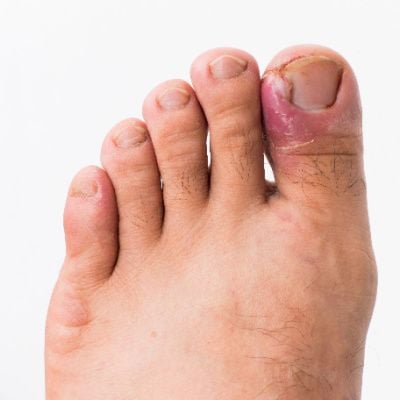 Ingrown toenails can be a painful and bothersome condition affecting people of all ages. This comprehensive guide will delve into the causes, symptoms, and effective treatments for ingrown toenails, providing insights into managing and preventing this common podiatric issue.
Ingrown toenails can be a painful and bothersome condition affecting people of all ages. This comprehensive guide will delve into the causes, symptoms, and effective treatments for ingrown toenails, providing insights into managing and preventing this common podiatric issue.
What Causes Ingrown Toenails?
- Improper Nail Trimming: Irregular or rounded nail cutting can contribute to ingrown toenails. Learning proper nail-cutting techniques is crucial for prevention.
- Tight Footwear: Shoes that squeeze the toes can exert pressure on the nails, increasing the likelihood of ingrowth. Choosing footwear with adequate space is essential.
- Injury or Trauma: Stubbing a toe or dropping a heavy object on the foot may lead to ingrown toenails, especially if the nail sustains damage.
Recognizing the Symptoms of Ingrown Toenails
- Pain and Tenderness: Ingrown toenails often cause pain and tenderness along the sides of the affected toenail.
- Swelling and Redness: Inflammation and redness around the toenail are common signs, indicating irritation and potential infection.
- Infection Signs: If left untreated, ingrown toenails can lead to infection, manifesting as pus, increased pain, and a sensation of warmth around the toe.
At-Home Care for Ingrown Toenails
- Warm Soaks: Soaking the affected foot in warm, soapy water can help reduce swelling and ease discomfort.
- Proper Nail Care: Gently lifting the ingrown edge of the nail and placing a small piece of cotton underneath may encourage proper growth.
- Avoidance of Tight Footwear: Wearing shoes with ample toe space can prevent further irritation.
Professional Treatment Options
- Podiatric Intervention: Podiatrists specialize in foot care and can provide professional assistance in resolving ingrown toenails.
- Nail Procedures: Partial nail avulsion or lifting procedures may be recommended to address ingrown toenails permanently.
- Topical Antibiotics: In cases of infection, topical antibiotics may be prescribed to prevent the spread of bacteria.
Prevention Strategies for Ingrown Toenails
- Proper Nail Cutting Techniques: Trimming nails straight across and avoiding rounded edges can minimize the risk of ingrowth.
- Footwear Selection: Opting for shoes with sufficient room for the toes and avoiding tight footwear is crucial in preventing ingrown toenails.
- Foot Hygiene Practices: Maintaining good foot hygiene, including regular washing and inspection, can contribute to overall nail health.
When to Seek Professional Help
Understanding when to consult a podiatrist is essential for prompt intervention. Persistent pain, signs of infection, or recurrent ingrown toenails warrant professional attention.
Conclusion
In conclusion, ingrown toenails are a common foot ailment with manageable solutions. By recognizing the causes, addressing symptoms promptly, and adopting preventive measures, individuals can maintain optimal foot health and prevent the recurrence of ingrown toenails. Seeking professional care when needed ensures accurate diagnosis and tailored treatment plans, promoting comfort and well-being for those affected by this podiatric concern.
Disclaimer:
The information on this website is provided for educational and information purposes only and is not medical advice. Always consult with a licensed medical provider and follow their recommendations regardless of what you read on this website. If you think you are having a medical emergency, dial 911 or go to the nearest emergency room. Links to other third-party websites are provided for your convenience only. If you decide to access any of the third-party websites, you do so entirely at your own risk and subject to the terms of use for those websites. Neither Howard Liebeskind, DPM, nor any contributor to this website, makes any representation, express or implied, regarding the information provided on this website or any information you may access on a third-party website using a link. Use of this website does not establish a doctor-patient relationship. If you would like to request an appointment with a health care provider, please call our office at (818) 347-9806.

